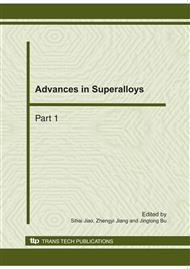p.1553
p.1557
p.1561
p.1565
p.1569
p.1574
p.1578
p.1583
p.1587
Study on Multifractal of Recrystallized Microstructure for TB8 Alloy
Abstract:
On the basis of MATLAB software,multi-fractal analysis program has been developed.Systematic fractal analysis of micrographs of TB8 alloy after hot compression deformation and solution treatment has been conducted.Corresponding probability measure and scale exponent from the microstructure images can be acquired and the multifractal spectra can be calculated.The results show that the microstructure of TB8 alloy after hot deformation and solution treatment has the characteristic of multi-fractal within the computing scale.And with increase of the recrystallized grain size and decrease of the deformed grain size,the width of the multi-fractal spectrum Δα decreases and the microstructure distribution is homogeneous.Furthermore,with increase of the recrystallization percent,the value between the maximum and minimum subset dimension Δf increases.It indicates that the recrystallized grains are the dominant factors in determining the size distribution in the microstructure and the grains are fine and uniform.These studies supply a new method for analyzing material microstructure quantitatively
Info:
Periodical:
Pages:
1569-1573
Citation:
Online since:
October 2010
Authors:
Price:
Сopyright:
© 2011 Trans Tech Publications Ltd. All Rights Reserved
Share:
Citation:


